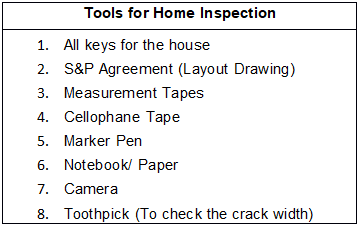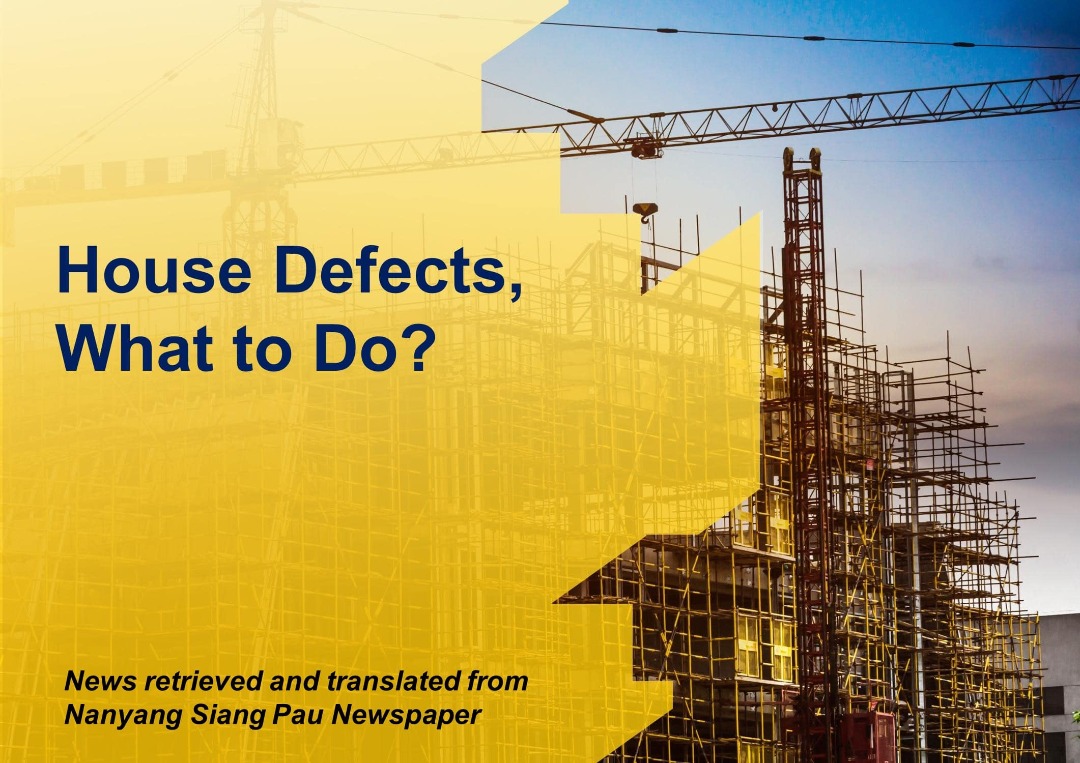December 02, 2018
The first thing that most of the new house owners would do after vacant possession is renovation instead of inspecting for house defects, and this mistake always leads to unnecessary disputes.
What is the function of the defect liability period? How owners use their rights to ensure that their houses are in good condition?
Home Inspection Tips for New House Owners
Owning a house is one of the major milestones in life. Many people are willing to spend most of their life working to own a house.
After long expecting, the houses are finally handed over by the developer, the feeling of the new house owners at that moment is extremely excited.
However, at the same time, their relatives and friends would urge them to do a detailed home inspection and ensure the developer to repair the house defects within the defect liability period. For those inexperienced house owners, there will be a lot of questions that come to their minds. What are the criteria that should be inspected?
After the house completion and handover, most of the developers would offer their warranty by repairing all defects due to poor workmanship such as tiles cracking, pipe leaking, malfunctioning doors and windows, uneven floor surface, etc. The warranty period mentioned here is Defect Liability Period (DLP).
This scenario is similar to the warranty we have during purchasing an electrical device, and the warranty period could be extended by paying more. Within the warranty period, if the electrical device has defects, the repairing cost is free-of-charge or even one-to-one exchange. However, this is impractical for houses.
The warranty period for a house could not be extended and the house is impossible to return or exchange. If the home inspection is not done correctly, the owner’s hard-earned money would be just wasted on the defected house. In addition, the owner needs to consume more time and energy to engage a contractor to repair the defects.
Therefore, after vacant possession, owners should check their houses thoroughly, all the way from the main entrance to the kitchen, from the living room to the balcony, from the bedroom to the bathroom, and never overlook any single corners. If there are any defects, owners must mark them clearly, and request developer to rectify as soon as possible. Otherwise, owners would have to spend their own money to fix the defects if the defect liability period is over.
Managing Director of IPM Professional Services Sdn Bhd, Ir. Justin Lai highlighted during the interview that the owners must pay attention to the date of notification letter after receiving from the developer, because the defect liability period starts after 14 days from the date of notification.
“If the vacant possession happens after a week from the notification, the defect liability period starts since the day of vacant possession.”
24-Months of Defect Liability Period
According to the Housing Development (Control and Licensing) Act 1966, Schedule G and H, either high-rise buildings or landed houses, the defect liability period is 24 months.
However, for commercial properties such as studio, service apartments, and SOHO units do not have a regulated defect liability period.
He urged those who wish to purchase a commercial property to study carefully on terms and conditions stated in the sales and purchase agreements before putting their signature on it.
“Commercial properties are not regulated by this law, the benefits of buyers are not protected, the developer could define the terms in sales and purchase agreement such as defect liability period, construction completion, delivery of Vacant Possession (VP), etc.”
In terms of the defect liability period, it depends on the agreement; normally it would be between 6 months to 1 year.
Spokesperson of Valerie Chong & Co Law Office, Valerie Chong said, some commercial properties do not have defect liability terms.
“If buyers intend to purchase a commercial property, it is important that the buyers shall understand all terms and conditions and own rights.”
She said, once buyers agreed with the sales and purchase agreement, it means that the buyers understood the risk and their rights of owning the commercial property.
“If the dispute happened between an owner and a developer due to defect liability, even being taken to court, it is hard for owners to get compensation. For example, if an owner purchased a service apartment and the developer committed to converting the title to residential before signing the sales and purchase agreement, however, due to the agreement signed is for commercial properties, it is very challenging to convert the title; at last, and the master title would be referred.”
 Table 1: Home inspection checklist
Table 1: Home inspection checklist
Mark the Defects
What should you do when found house defects during an inspection? During vacant possession, the developer will distribute a standard house defect checklist to owners for inspection. However, Ir. Justin Lai suggested that owners should record and mark the defects clearly to better protect their rights.
“The checklist is only for reference but not a standard, if owners can record the defects, it will surely provide more detail and complete information about the defects.”
Valerie Chong pointed out that, while inspecting for house defects, owners must bring along the layout plan attached in the sales and purchase agreement to check if the overall layout and the area of the house are the same as in the layout plan attached.
“During construction, developer might do some adjustments on the layout. For example, sometimes the actual area of the house is bigger than the proposed layout, especially for commercial properties. Under such circumstances, the owners are required to pay extra to the developer according to the price per square feet as agreed.”
 Table 2: Steps for house defect inspection
Table 2: Steps for house defect inspection
Must Retain the Balance Payment if Defects Repairing at Own Costs
If owners decide to repair the defects at own cost, they must notify the real estate lawyers officially to retain the last 5% balance payment from the developer.
Ir. Justin Lai pointed out that if owners have made a written request to the developer about the house defects, the developer must repair the defects within 30 days.
“If the developer did not take any action, owners can issue a notification letter and emphasising that 30 days had been exceeded, and state clearly that if the developer does not intend to repair, owners will engage their own contractor to repair it. The official quotations shall be submitted together with the notification letter.”
He said, generally after submitted the quotation, the developer definitely would repair the defects but there are some exceptions for sure.
“If you are one of the exceptions and going to engage your own contractor to repair the defects, then before starting any work, you must write a letter to notify the real estate lawyers to explain clearly the whole incident included that developer didn’t take any actions even though have been given 60 days notification, therefore, you are forced to repair the defects yourselves, and request the lawyer to hold the last payment release to the developer.”
If owners have engaged a contractor to repair the house defects, then they could claim the repairing costs from the lawyer after the work completion.
Never Allow Developer to Drag until to the Sixth Months
Generally, real estate lawyers will retain the balance 5% payment as the house repairing fund.
Ir. Justin Lai explained, the developer would claim 2.5% of the fund in the eighth month after vacant possession, and the remaining 2.5% will be released to the developer after the defect liability period.
“Developers are released the first 2.5% by the eighth month, therefore, while handling the issue of house defects, owners should deal with it as soon as possible, never allow the developer to drag until the sixth month.”
He worriedly pointed out that, some developers would use various excuses to delay the repairing work, and the owners still do not aware of it. Once the developer received the first 2.5% of the payment, they are even more reluctant to assist owners to repair the defects.
“If the developer continues to drag on until the end of the defect liability period, the developer does not bear the responsibility of repairing the defects any more. At that time, owners can only blame themselves for their slow reaction, and they have to repair the defects and bear the cost themselves.”
Never Underestimate Wall and Floor Cracking
It is urged that never underestimate wall and floor cracking. If the crack width exceeds 2 mm, it is probably a structural crack. For public safety purposes, it is recommended to engage structural engineers to conduct a proper inspection and checking.
Ir. Justin Lai pointed out that, people tend to take cracked walls and floors easily. If the cracks are the sign of the structural defects, it could be a time and cost consuming process to repair it later.
“Structural damage could be scary. If the crack exceeds 2 mm, it is probably structural damage; it is advisable to engage a structural engineer to conduct proper checking. However, if the crack is less than 2 mm, you could just request the developer to fix it.”
There are a few reasons that caused structural cracks, such as the thermal expansion and contraction due to extreme temperature difference, insufficient load-bearing capacity, earthquake or landslide, the chemical reaction of construction material, etc.
He stated that, if owners discovered cracks during an inspection, they can check if it is a structural crack by using a toothpick. If the toothpick can be inserted into the crack, then it represents a high chance of structural crack.
“Do not think that the cracked floor or wall is always due to poor workmanship, it might be a sign of the structural damage.”
“This is a serious issue. Never take it easy and just applying a layer of cement on the surface to cover it. The correct way to deal with it is to do a thorough investigation to find the root cause and get rid of it.”
Not Necessary to Engage Specialist for Inspection
Is it necessary to engage a building inspector to inspect a new house and get better protection?
Ir. Justin Lai and Valerie Chong both declined the statement!
“It is not necessary to spend to engage a specialist for home inspection. As long as you inspect the house according to the step recommended, record all defects properly and submit to developer, then you would be well protected as well.”
The most common defects during a home inspection are floor and wall cracking, uneven wall and floor surface, water pipe leakage, malfunction window, pipe burst, blocked water downpipe, clogged sewer pipe, etc.
Ir. Justin Lai, who is a Professional Engineer, stated that it is not necessary to spend to engage a specialist to inspect your new house.
“These common defects are not difficult to be discovered. Unless the house has the sign of structural damage, then only it is required to appoint a building inspector to do a proper inspection.”
In terms of the time needed to do the home inspection, it solely depends on how particular the owners are. If every tile must be touched, or every wall and floor must be inspected carefully, then at least half of a day is needed.
 Table 3: Tools for home inspection
Table 3: Tools for home inspection
One Year Defect Liability Period for Common Area
For high-rise buildings, if owners found defects for common facilities, they have the right to inspect and make an official complaint to the developer.
Ir. Justin Lai pointed out that, according to Housing Development (Control and Licensing) Act 1966, Schedule G Clause 15 and Schedule H Clause 14, if the defects are found in common facilities such as lifts, swimming pools, etc, owners have the right to check and complain.
“Common area is for everyone, if owners found some defects, then they can make the corresponding complaints.”
From the perspective of law, Valerie Chong said if owners found some defects and made a complaint, the developer should handle the issue.
“However, there is an important note to owners that defect liability period for the common area is only limited to 1 year. If owners do not satisfy or discover defects, they should notify the developer as soon as possible.”
According to Strata Management Act 2013, the developer must set up a Joint Management Body (JMB) after 12 months to handle and manage the condominium in the future.
After setting up the JMB, JMB is responsible to maintain the common area.
Renovation is not covered under the Warranty
After the renovation, the developer would no longer guarantee any defect?
Ir. Justin Lai stated that only the parts that have been renovated are excluded from the warranty, the rest are still included.
“For example, if you have renovated the kitchen and the tiles or walls crack in the future, the developer has no obligation to repair it. However, if you found defects in other areas such as living room, bedroom, or bathroom that never be renovated, and still within the 24-month defect liability period, you could still request the developer to repair it.”
Valerie Chong reminded owners that, it is better to take photos of every corner of the house before any renovation. If some disputes occurred in the future, these photos could be the evidence.
“For double confirmation, before starting any renovation works, you can request the contractor to check your house one more time, especially those risky places such as the ceiling or water pipes, check if there is any sign of water leakage.”
Sub-buyers have the Right to Complain
As long as it is still within the defect liability period, owners can request the developer to repair the defects as many times as they want, the same rights go for sub-buyers.
When Ir. Justin Lai was asked whether owners have the right to unlimited request developer to repair the deflects, he responded that as long as it is still within the defect liability period, then owners could request as many times as they want.
“However, if the same defect has been repaired numerous times but yet to be resolved, then the root cause of the defect must be determined to solve it permanently.”
He reminded owners, if the same defect could not be resolved within a 24-month of defect liability period, then it remains as the responsibility of the developer to repair it even after the defect liability period.
“However, if you wrongly lodge a complaint about water leakage in the kitchen initially and eventually found out that the root cause of the leakage is in another room after 24 months, thus under such circumstance, the developer has no obligation to repair it anymore.”
If the first buyers sell their house after one year from vacant possession, is the sub-buyers still enjoy the benefits during the defect liability period? Valerie Chong pointed out that, from the perspective of law, sub-buyers still have the right to claim the warranty if they found defects in their house.
“After signing the sales and purchase agreement, the sub-buyers have also bought the rights and benefits from the first buyers. Therefore, as long as within the 24-months of defect liability period, once they found defects in their house, they can request the developer to repair them.”
She stated that, if the sub-buyers worried that they will face some difficulties while claiming the warranty, they can request the first buyers to sign an authorisation document to transfer their rights to them as a precautious to avoid future disputes.
Case Study: Underground Works to Solve Clogged Sewerage Pipe
Ir. Justin Lai has experience with his own house that faces with clogged manure pipe. At that time, he notified the developer, but they failed to solve it after several attempts. Eventually, the developer has to dig out the underground manure pipe to clear it.
“I also recorded the defects of my house clearly and sent it to the developer officially. When the developer responded, we then figured out the root cause of the defects together.”
He pointed out that, normally if a clogged manure pipe happened, the developer would first clear the pipe next to the kitchen.
“If after doing so, the problem is still unsolved, the developer has to dig out the underground pipe to clear it, and then only the problem could be resolved permanently.”
News retrieved and translated from Chinese-language newspapers, Nanyang Siang Pau, published on 2 December 2018, reported by林妤芯
https://www.enanyang.my/news/20181202/%e6%88%bf%e5%b1%8b%e6%9c%89%e7%bc%ba%e9%99%b7%e6%80%8e%e4%b9%88%e5%8a%9e/
**This English translation is for reference only. If the meaning of the English translation is inconsistent with the original Chinese version, the original Chinese version shall prevail.

